- Art
- Exhibitions
- Tintoretto’s Genesis
- Cycle Thru! The Art of the Bike
- Shahzia Sikander: Collective Behavior
- Upcoming Exhibitions
- Online Exhibitions
- Special Features
- Past Exhibitions
- Explore the Collection
- Provenance and Cultural Property
- Conservation
- Meet the Curators
- Digital Resources
- Art Bridges Cohort Program
Introduction
Hi, I’m Amy Dehan, the museum’s curator of decorative arts and design. I will be sharing the exhibition’s introduction.
Cruising through this exhibition, you will see more than 20 bicycles, from the earliest prototypes to the latest designs. The first true bicycle—a human-powered land vehicle with two wheels, rotary cranks, and pedals—appeared in Paris in the late 1860s. Since then, designers and engineers have continuously explored and adapted its form. As you tour through the visual and functional evolution of the bikes on view, consider what might have prompted these changes. Was comfort, safety, or speed at the center of these reinterpretations, or did designers and manufacturers prioritize fashionable styles, social trends, or other considerations?
Since its debut, the bicycle has permeated all corners of modern life. Artists worldwide have taken note, documenting people on their bicycles and highlighting the vehicle’s role in providing greater autonomy and freedom to all, regardless of age, gender, and geography. Through a selection of artworks from the museum's collection, observe how social culture and art intersect through this iconic vehicle.
Unless noted otherwise, all bicycles are loans courtesy of the Bicycle Museum of America, New Bremen, Ohio.
The Cycle Begins: Early Bicycles and Cyclists (1860s–1880s)
Hi, I’m Amy Dehan, the museum’s curator of decorative arts and design. I will be sharing the introduction to the “The Cycle Begins: Early Bicycles and Cyclists (1860s–1880s)” section of the exhibition.
The first true bicycle debuted in Paris in the 1860s—a slender but heavy two-wheeled ride built of wood and cast iron with pedals at the center of the front wheel. Although it quickly (and deservedly) became known as the "boneshaker," this early bike—called a velocipede—captured the world's imagination, spurring an outburst of creativity and experimentation that continues today.
Although this new independent alternative to horse-powered transportation exhilarated many, the first riders were predominately privileged young men. The precarious design of the 1870s and 1880s high wheel was prohibitive to most women cyclists, but it set the scene, technically and socially, for the low-mount safety bicycle. With its introduction, bikes became more accessible, soon offering greater independence and autonomy to more people. Susan B. Anthony observed, "bicycling . . . has done more to emancipate women than anything else in the world. It gives women a feeling of freedom and self-reliance." Although Anthony likely centered white female cyclists in her statement, women of color—like Katherine Towle "Kittie" Knox—similarly used the bicycle as a tool for their equal rights activism in the late 1800s.
Ariel High Wheel
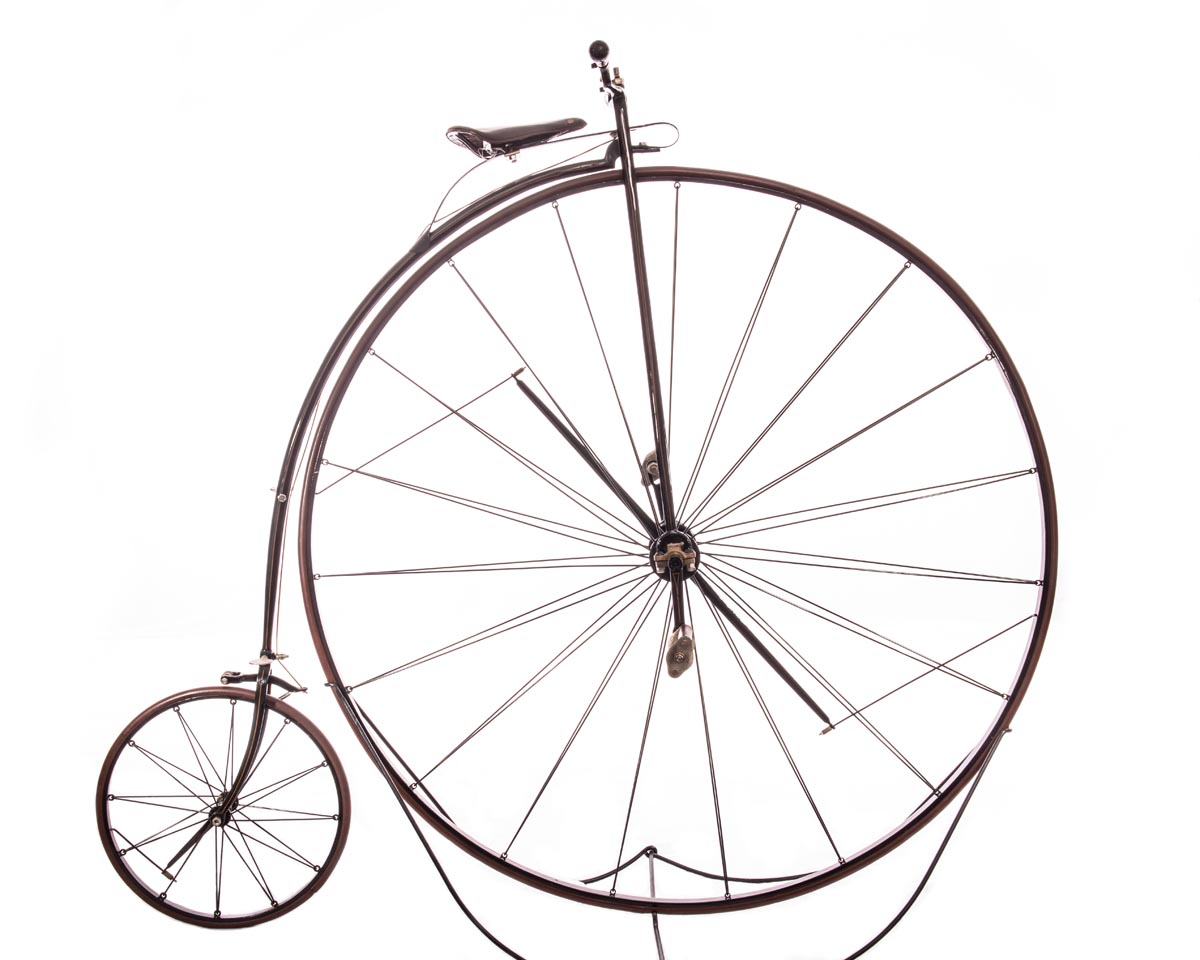
Ariel High Wheel, 1878, Coventry Machinists Company (English), steel with leather saddle, Bicycle Museum of America, New Bremen, Ohio
Description
Hi, I’m Amy Dehan, the museum’s curator of decorative arts and design. I will be sharing a description of the Ariel High Wheel in Cycle Thru! The Art of the Bike.
The Ariel High Wheel is made of steel and features a leather saddle. The English Coventry Machinists Company produced it in 1878. It is in the collection of The Bicycle Museum of America in New Bremen, Ohio.
Towering over traditional bicycles, the Ariel High Wheel measures 64 by 72 by 22 inches, or 162.56 by 182.88 by 5.08 centimeters. Exhibiting a rich, deep brown overall color, this high-wheeled style cycle is comprised of a massive wheel with 19 spokes in the front and a smaller wheel with 12 spokes at the back. This smaller rear wheel is a quarter of the size of the large front wheel. Perched atop the large front wheel is a triangular leather saddle and straight handlebars. A steel frame, connected at the base of the handlebars and holding the brake line, swoops under the seat and along the circumference of the large wheel, terminating in the small wheel with a brake. Two arms of the frame also extend from the handlebars to either side of the large wheel. Two pedals are connected to the center of this front wheel.
Label
Hi, I’m Amy Dehan, the museum’s curator of decorative arts and design. I will be sharing the label for the Ariel High Wheel in Cycle Thru! The Art of the Bike.
The Ariel High Wheel is made of steel and features a leather saddle. The English Coventry Machinists Company produced it in 1878. It is in the collection of The Bicycle Museum of America in New Bremen, Ohio.
The high wheel became popular in the 1870s. This type of bicycle is also known as a penny-farthing—a nod to the British penny and farthing coins. The large front wheel references the penny while the smaller back wheel invokes the diminutive farthing.
The Ariel was the first commercially produced high-wheeled bicycle in England. When American cyclists could only import bicycles, the Ariel was the best and most popular machine for those who dared ride such a vehicle. The Coventry Machinists Company’s prominent display of the Ariel at the Centennial Exposition in Philadelphia kickstarted its popularity in the states.
Otto Dicycle
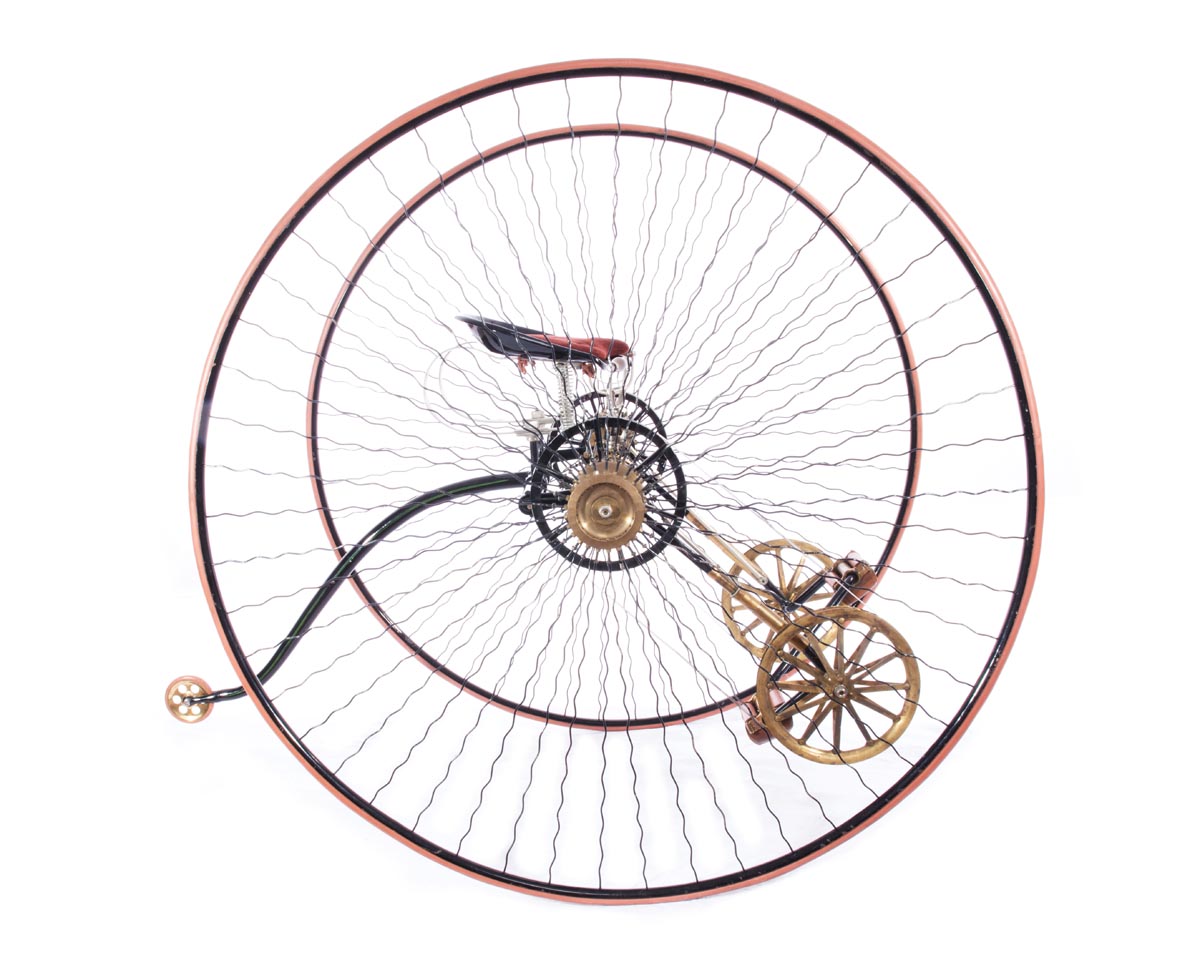
Otto Dicycle, circa 1880, Edward Otto (English), designer, Birmingham Small Arms Company Limited (English, 1861–1973), manufacturer, steel with leather saddle, Bicycle Museum of America, New Bremen, Ohio
Description
Hi, I’m Amy Dehan, the museum’s curator of decorative arts and design. I will be sharing a description of the Otto Dicycle in Cycle Thru! The Art of the Bike.
Produced around 1880, the Otto Dicycle is made of steel and features a leather saddle. The designer, Edward Otto, and the manufacturer, the Birmingham Small Arms Company Limited (1861–1973), were from England. It is in the collection of The Bicycle Museum of America in New Bremen, Ohio.
The Otto Dicycle measures 52 by 64 by 32 inches or 132.08 by 162.56 by 81.28 centimeters. Unlike traditional bicycles, the dicycle features two large, equally sized wheels on the seat's left and right sides. The rider sits on a slightly concave seat with a red padded cushion suspended above a metal support that connects the centers of each wheel. A black, slightly curved bar extends backward from this central support and ends in a tiny wheel. Angled diagonally down and in front of the rider, the two large wheels feature smaller wheels connected by a horizontal axle, which holds the pedaling mechanism. All three of the smaller wheels are brushed bronze in color. The steel frame of the large wheels, their many thin wavy spokes, and the saddle's structure are black except for the silver springs under the seat. The wheels are rimmed in a light brown or tan color.
Label
Hi, I’m Amy Dehan, the museum’s curator of decorative arts and design. I will be sharing the label for the Otto Dicycle in Cycle Thru! The Art of the Bike.
Produced around 1880, the Otto Dicycle is made of steel and features a leather saddle. The designer, Edward Otto, and the manufacturer, the Birmingham Small Arms Company Limited (1861–1973), were from England. It is in the collection of The Bicycle Museum of America in New Bremen, Ohio.
For women living in the 1880s, showing an ankle could create scandal. Although some daring women mounted high wheels in side-saddle fashion, others sought safer options such as the Otto Dicycle. Advertised as "safe, fast and comfortable . . . the only [cycle] suitable for Ladies," it accommodated women's full long skirts without risk of "indecent exposure" (or broken bones). Riders used double handles on either side of the seat to brake and turn. The inner handles control the brake mechanisms, while the outer handles engage the belt, pulley, and gear system that moves the wheels.
Putting the Pedal to the Metal: Cycling’s Height of Popularity (1890s)
Hi, I’m Mackenzie Strong, the museum’s curatorial assistant for decorative arts and design. I will be sharing the introduction to the “Putting the Pedal to the Metal: Cycling’s Height of Popularity (1890s)” section of the exhibition.
By the late 1880s, the low-mount safety bicycle with two equally sized wheels and a chain drive had surpassed the high wheel in popularity. Bicycle clubs and races abounded in the final decade of the 1800s. Continued improvements such as weight reduction, rigid diamond-shaped frames, and pneumatic (air-filled) tires made for smoother, easier rides. Bikes became more affordable as the international cycle industry expanded in size and productivity to meet the growing demand for bicycles. In 1896, some 300 firms in the United States alone produced more than a million bicycles. Competing for sales, designers created various models for men, women, and children. The mid-1890s brought a massive influx of women cyclists—making up at least one-third of the total market. Feminists saw the bicycle as a social and political vehicle that could improve women’s lives through exercise and dress reform.
Bronco Style Pneumatic Safety
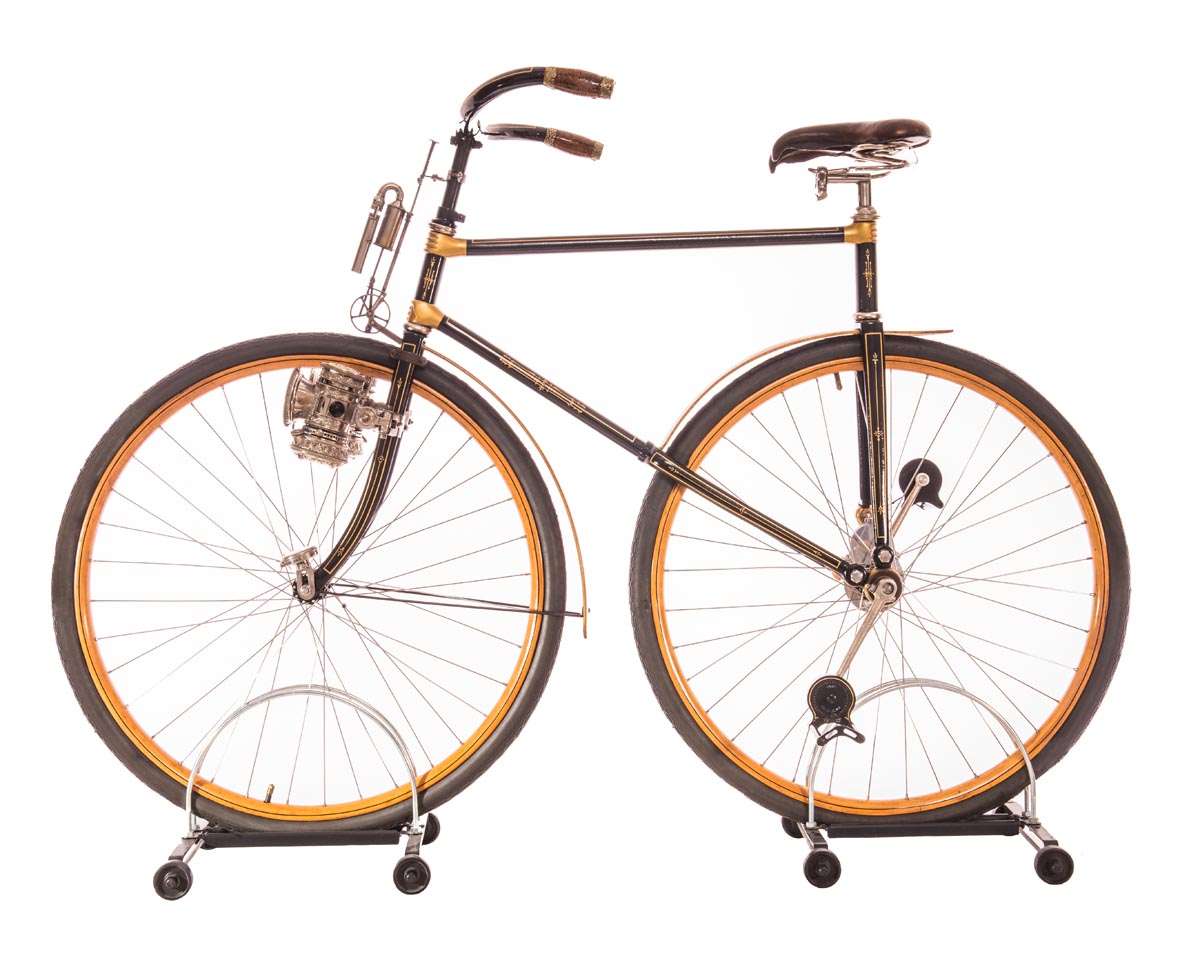
Bronco Style Pneumatic Safety, 1891, once-known maker, steel with leather saddle, Bicycle Museum of America, New Bremen, Ohio
Description
Hi, I’m Mackenzie Strong, the museum’s curatorial assistant for decorative arts and design. I will be sharing a description of the Bronco Style Pneumatic Safety in Cycle Thru! The Art of the Bike.
The Bronco Style Pneumatic Safety, produced in 1891, is made of steel and features a leather saddle. A once-known maker manufactured it. It is in the collection of The Bicycle Museum of America in New Bremen, Ohio.
The Bronco Style Pneumatic Safety bicycle measures 36 by 56 by 16 inches or 91.44 by 142.24 by 40.64 centimeters. This bike’s structure takes a familiar form. It features one front wheel and one rear wheel, which are equal in size and are connected by a triangular frame. The seat sits directly over the center of the rear wheel, with the pedal mechanism attached to the same wheel. On either side of the front wheel, attached to the metal frame that connects the wheel to the handlebars above, are two silver lamps, and just above these lights is a horn. The handlebars curve back in a wide U-shape towards the rider, and the wheels feature thick, rubber tires. The bike is black with gold detailing. Someone—possibly the designer or a previous owner—decorated each end of a horizontal bar that connects the vertical bars supporting the saddle and the handlebars with small gold human hands. Another gold hand was added to the diagonal frame, stretching up from the rear wheel and pedals to the front of the bike just above the wheel and silver lamps.
Label
Hi, I’m Mackenzie Strong, the museum’s curatorial assistant for decorative arts and design. I will be sharing the label for the Bronco Style Pneumatic Safety in Cycle Thru! The Art of the Bike.
The Bronco Style Pneumatic Safety, produced in 1891, is made of steel and features a leather saddle. A once-known maker manufactured it. It is in the collection of The Bicycle Museum of America in New Bremen, Ohio.
Designed as a less dangerous alternative to the high wheel, the aptly named "safety bicycle" eventually prevailed as the universal style. Both tires are the same size, placing the rider's feet closer to the ground and making it easier to stop. This "bronco-style" design places the seat over the pedals at the back wheel, akin to how a person would ride a wild horse, or bronco, (their legs close to the animal's body for stability and control). It also features an experimental triangular frame with pneumatic (air-filled) tires and a gear-driven axle crank. It was prized as chainless and noiseless, making the bell and lights smart additions. To further personalize this example, someone whimsically painted the "hands" that connect the frame elements.
Rex Cycle
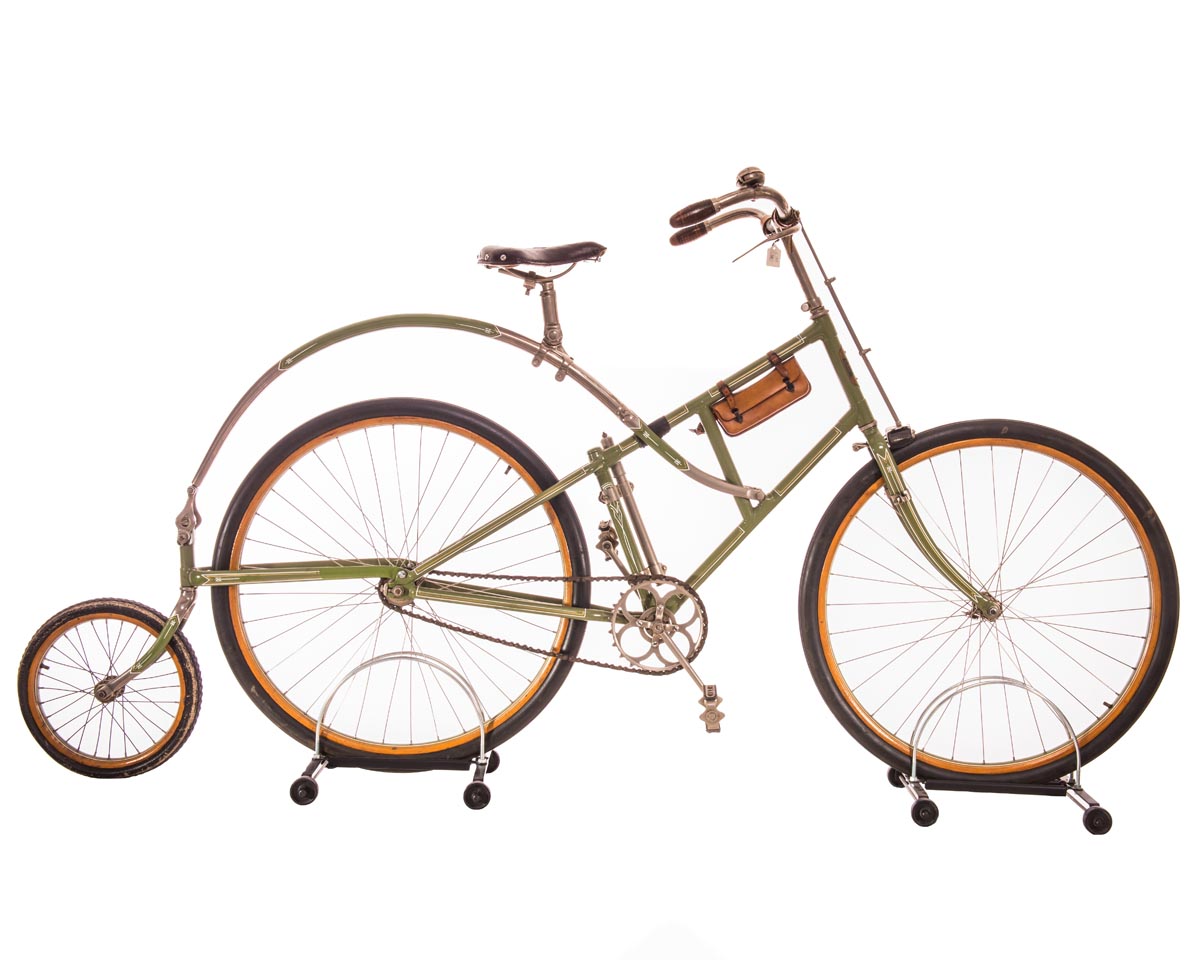
Rex Cycle, 1898, Rex Cycle Company (American, active late 1800s), manufacturer, Bohn C. Hicks (1852–1910), designer, steel with leather saddle, Bicycle Museum of America, New Bremen, Ohio
Description
Hi, I’m Mackenzie Strong, the museum’s curatorial assistant for decorative arts and design. I will be sharing a description of the Rex Cycle in Cycle Thru! The Art of the Bike.
The Rex Cycle, from 1898, is made of steel and features a leather saddle. It was designed by Bohn C. Hicks (1852–1910), and manufactured by the Rex Bicycle Company (American, active in the late 1800s) was the manufacturer. It is in the collection of The Bicycle Museum of America in New Bremen, Ohio.
The Rex Cycle measures 45 by 87 by 19 inches or 114.3 by 220.98 by 48.26 centimeters. The most distinctive feature of this olive green-colored and chrome-plated bike is its third wheel. The bike’s frame features a typical front and rear wheel of equal size. The third, smaller wheel extends behind the rear wheel, measuring a quarter of its size. All three wheels have rubber tires. The rear, or second, wheel is attached to the handlebar-support bar atop the front wheel via two metal downward-slanted central bars. Attached to the frame’s top bar is a small tan leather pouch with two buckles. The pedals are positioned between the bike's two main wheels, directly under the seat. Another distinctive feature of the Rex Cycle, the seat is perched atop a stem that attaches to a bar that curves along the back wheel and connects to the third wheel. The handlebars, complete with a bell, sit wide apart, bending back in a loose U-shape toward the rider.
Label
Hi, I’m Mackenzie Strong, the museum’s curatorial assistant for decorative arts and design. I will be sharing the label for the Rex Cycle in Cycle Thru! The Art of the Bike.
The Rex Cycle, from 1898, is made of steel and features a leather saddle. It was designed by Bohn C. Hicks (1852–1910), and manufactured by the Rex Bicycle Company (American, active in the late 1800s). It is in the collection of The Bicycle Museum of America in New Bremen, Ohio.
Road quality was low in the 1890s. Seeking a smoother ride, Bohn C. Hicks developed the Rex Cycle. By attaching the seat to the stem that runs from the handlebar to the third wheel, Hicks hoped the two larger wheels would absorb most of the vibrations and jostle the rider less. The Rex Cycle never caught on, and few exist today. This example boasts a bespoke anatomical saddle to support and protect the rider, handlebar bell, tool pouch, and cyclometer.
Stoddard Cygnet
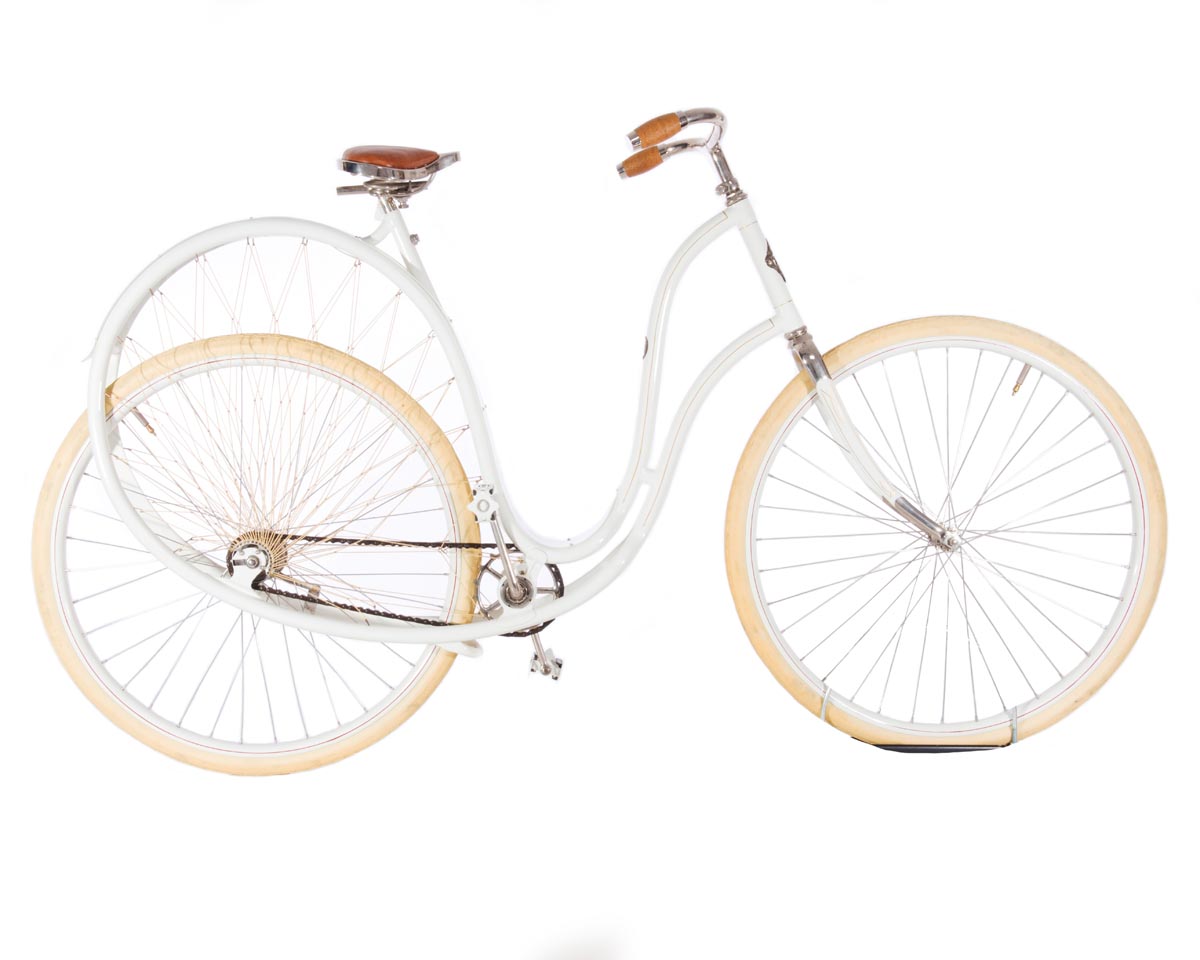
Stoddard Cygnet, circa 1898, Stoddard Manufacturing Company (American, active 1890s), steel and plastic with leather saddle and cloth skirt guard, Bicycle Museum of America, New Bremen, Ohio
Description
Hi, I’m Dave Linnenberg, the museum's chief administrative officer. I will be sharing a description of the Stoddard Cygnet in Cycle Thru! The Art of the Bike.
The Stoddard Cygnet was produced around 1898. It is made of steel and plastic and features a leather saddle and cloth skirt guard. The Stoddard Manufacturing Company (American, active in the 1890s) was the manufacturer. It is in the collection of The Bicycle Museum of America in New Bremen, Ohio.
The Stoddard Cygnet cycle measures 39 by 71 by 17 inches or 99.06 by 180.34 by 43.18 centimeters. This white bike is all swooping curves. Designed for female cyclists, the tubular frame’s central double bars run down from the handlebar stem towards the pedals, where they split. The frame’s top bar runs up to the saddle and above the back wheel, where it joins with the lower bar, which runs across the rear wheel parallel to the chain mechanism. Forming one continuous curved line, the shape of these joined frame bars creates a dress guard with string “spokes” that sits over and above the rear wheel. This dress guard resembles the rear plumage of a swan as it paddles around a pond. The saddle and the grips on the wide-set handlebars are tan leather, and both wheels have cream-colored rubber tires and white metal frames.
Label
Hi, I’m Dave Linnenberg, the museum's chief administrative officer. I will be sharing the label for the Stoddard Cygnet in Cycle Thru! The Art of the Bike.
The Stoddard Cygnet was produced around 1898. It is made of steel and plastic and features a leather saddle and cloth skirt guard. The Stoddard Manufacturing Company (American, active in the 1890s) was the manufacturer. It is in the collection of The Bicycle Museum of America in New Bremen, Ohio.
The elegant lines of the Cygnet women's bicycle nod to its namesake (a cygnet is a young swan) and the whiplash curves of the era's Art Nouveau design style. The protective netting guard covering the rear of the bicycle kept riders' long dresses from becoming entangled in the wheel spokes. The Stoddard Manufacturing Company of Dayton, Ohio, initially manufactured agricultural implements and then bicycles between 1895 and 1899. After that, they reorganized as the Dayton Motor Car Company and shifted their focus to the design and production of automobiles. Fewer than 10 examples of this bicycle are known to exist today.
Old Hickory
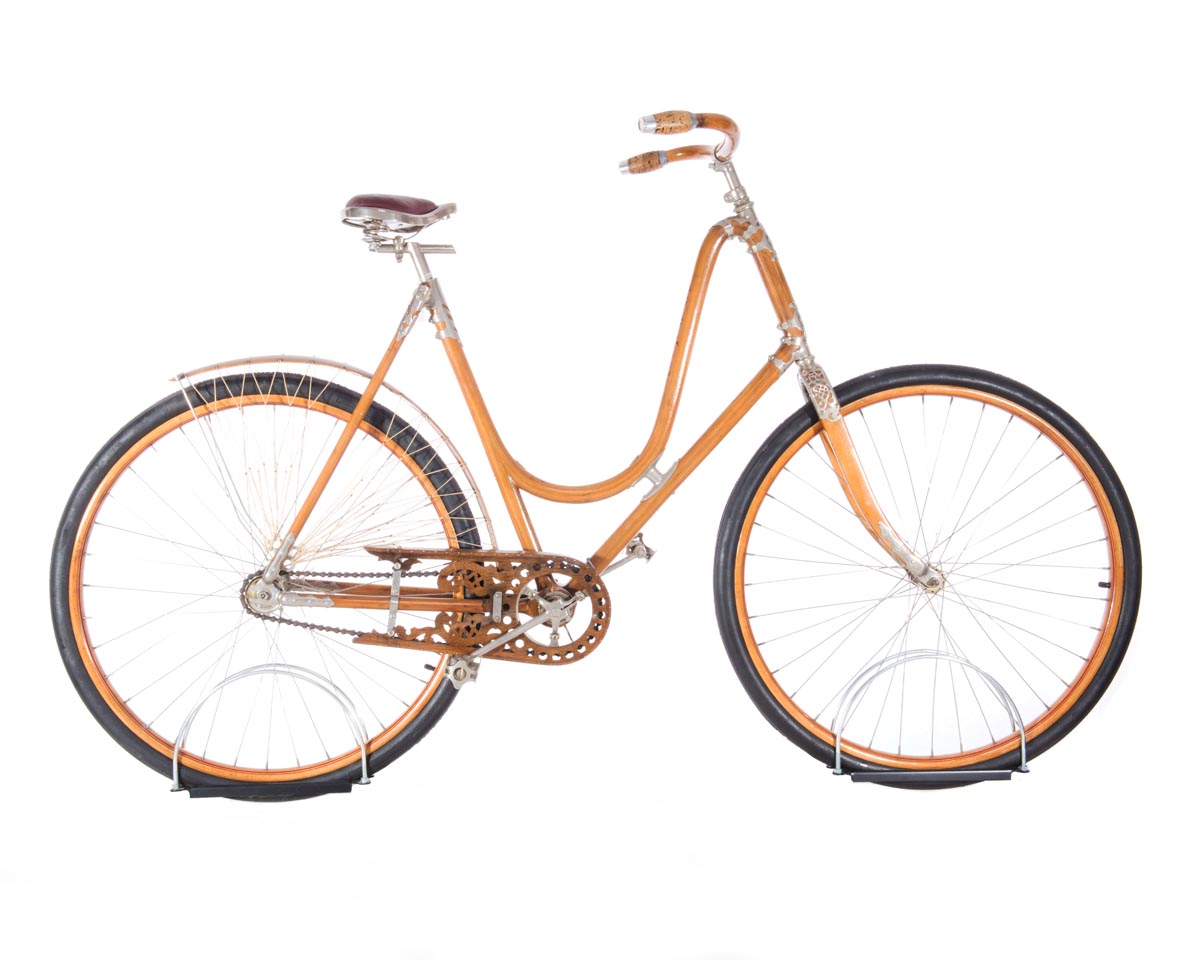
Old Hickory, 1898, Old Hickory Cycle Company (American, active late 1890s), hickory frame with leather saddle, Bicycle Museum of America, New Bremen, Ohio
Description
Hi, I’m Dave Linnenberg, the museum's chief administrative officer. I will be sharing a description of the Old Hickory in Cycle Thru! The Art of the Bike.
Old Hickory has a hickory frame and leather saddle. The Old Hickory Cycle Company (American, active in the late 1890s) manufactured the cycle in 1898. It is in the collection of The Bicycle Museum of America in New Bremen, Ohio.
The Old Hickory cycle measures 48 by 72 by 20 inches or 121.92 by 182.88 by 50.8 centimeters. This bike’s outstanding feature is its hickory construction, giving it a warm tan color. Another distinctive design element is the detailed chrome scrollwork decoration at the saddle's base, on the curved bar connecting the handlebars and the seat to the front wheel, and at the center of both wheels. This scrollwork repeats on a wooden fender, stained a richer, walnut brown color, which covers the pedal mechanism. Due to its deeply curved central bar and the dress guard over the rear wheel, this cycle’s rider was likely female. The saddle, edged in chrome, is purple-brown leather. The handlebars, also hickory, are wide set with handles, each tipped in chrome, reaching back in a loose U-shape to the rider. The wheels have rubber tires, and the wire spokes are spiraled.
Label
Hi, I’m Dave Linnenberg, the museum's chief administrative officer. I will be sharing the label for the Old Hickory in Cycle Thru! The Art of the Bike.
The Old Hickory has a hickory frame and leather saddle. The Old Hickory Cycle Company (American, active in the late 1890s) manufactured the cycle in 1898. It is in the collection of The Bicycle Museum of America in New Bremen, Ohio.
This women's safety bicycle is made from layers of laminated and steam-bent hickory. Its wheels feature spiral-twisted "sparkle" spokes that catch the sunlight and twinkle as the rider cycles along. Max Tonk, an owner of The Old Hickory Cycle Company, was a Chicago-based wood carver and manufacturer of furniture. He surely lent his expertise to the manufacture of this stylish wooden ride.
Knoll Spring Frame
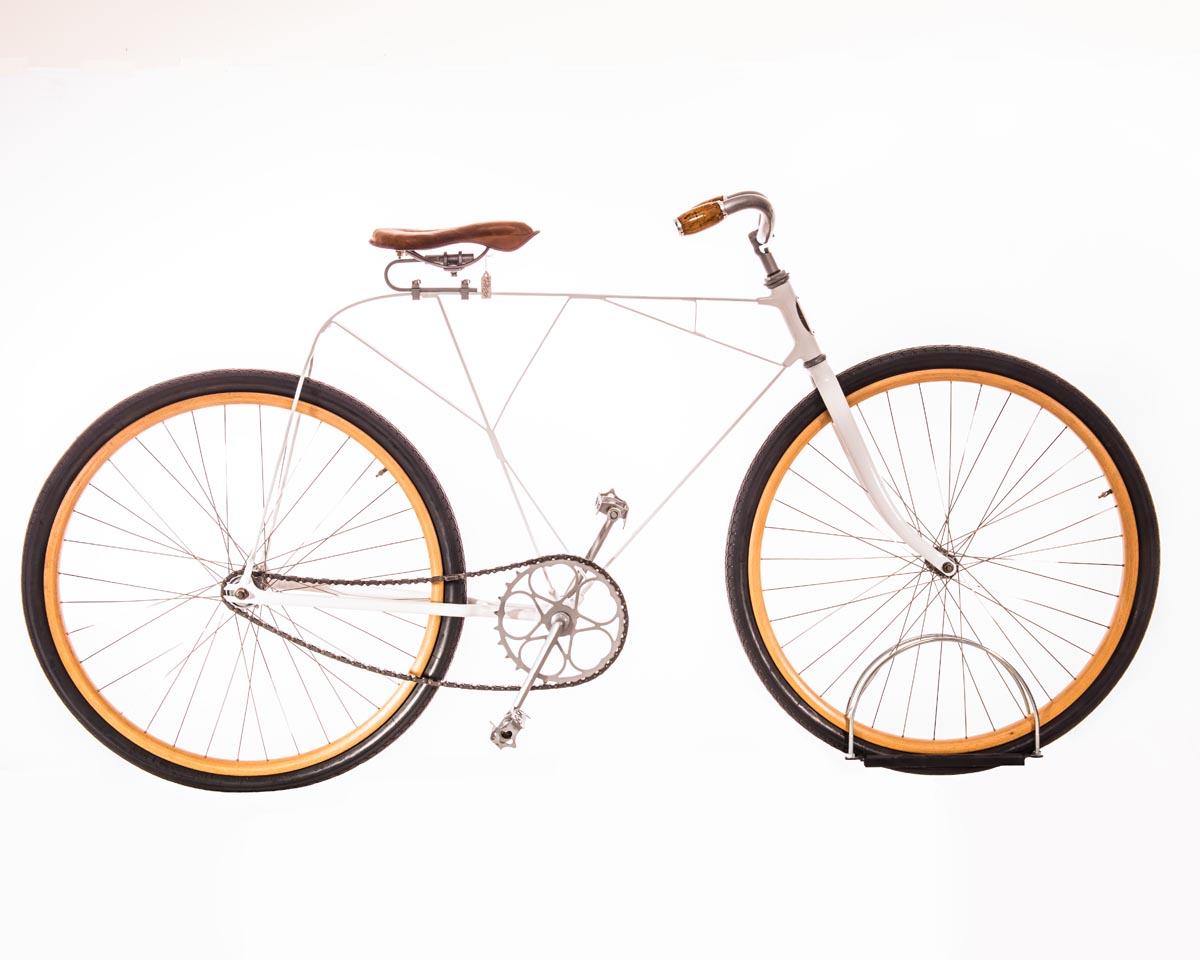
Knoll Spring Frame, 1899, Reverend Jonas L. Knoll (American, 1847–1902), steel frame with leather saddle, Bicycle Museum of America, New Bremen, Ohio
Description
Hi, I’m Amy Burke, the museum's director of visitor experience. I will be sharing a description of the Knoll Spring Frame in Cycle Thru! The Art of the Bike.
The Knoll Spring Frame has a steel frame and leather saddle. Reverend Jonas L. Knoll (American, 1847–1902) designed it in 1899. It is in the collection of The Bicycle Museum of America in New Bremen, Ohio.
The Knoll Spring Frame cycle measures 42 by 72 by 18 inches or 106.68 by 182.88 by 45.72 centimeters. The bike’s white steel frame, which connects the front and back wheels, seat, and handlebars, is thin and minimal. A straight central crossbar runs horizontally from the handlebar stem underneath the brown leather saddle and down to the center of the rear wheel, where it ends. The saddle is mounted on this horizontal bar so that it appears to float above the bike. Additional thin steel bars stretch from the seat's base and the bottom of the handlebar stem diagonally to meet the pedal mechanism between the front and back wheels. Thin cross bars run between the frame components, adding stability. The chain attaching the pedals to the rear wheel is exposed. The wheels are light brown with thick black rubber tires. The chrome-colored handlebars are wide set, with brown grips reaching back to the rider.
Label
Hi, I’m Emily Agricola Holtrop, the museum's director of learning & interpretation. I will be sharing the label for the Knoll Spring Frame in Cycle Thru! The Art of the Bike.
The Knoll Spring Frame has a steel frame and leather saddle. Reverend Jonas L. Knoll (American, 1847–1902) manufactured it in 1899. It is in the collection of The Bicycle Museum of America in New Bremen, Ohio.
In 1899, Reverend Jonas L. Knoll of Lebanon, Pennsylvania, patented his Spring Frame bicycle. He made the frame from flat spring steel stock, designed to "flex" when riding. Knoll also patented the Knoll Double Action Washing Machine. When he died at 52, his wife, Mary Knoll, took over the management of their bicycle and washing machine factories. This is one of only three surviving Knoll Spring Frame bike examples.
Reinventing the Wheel: Unusual Bikes at the Turn of the Century (1900s–1910s)
Hi, I’m Emily Agricola Holtrop, the museum’s director of learning & interpretation. I will be sharing the introduction to the “Reinventing the Wheel: Unusual Bikes at the Turn of the Century (1900s–1910s)” section of the exhibition.
Bicycles had become part of the everyday by the 1900s. They were socially acceptable and generally affordable. They also advanced campaigns for women's independence and improved roadways. Searching for the next revolution in cycling, engineers and inventors applied new ideas to what had become the standard bicycle, resulting in these intriguing (and quirky) variations.
Wolff-American Ice Bicycle
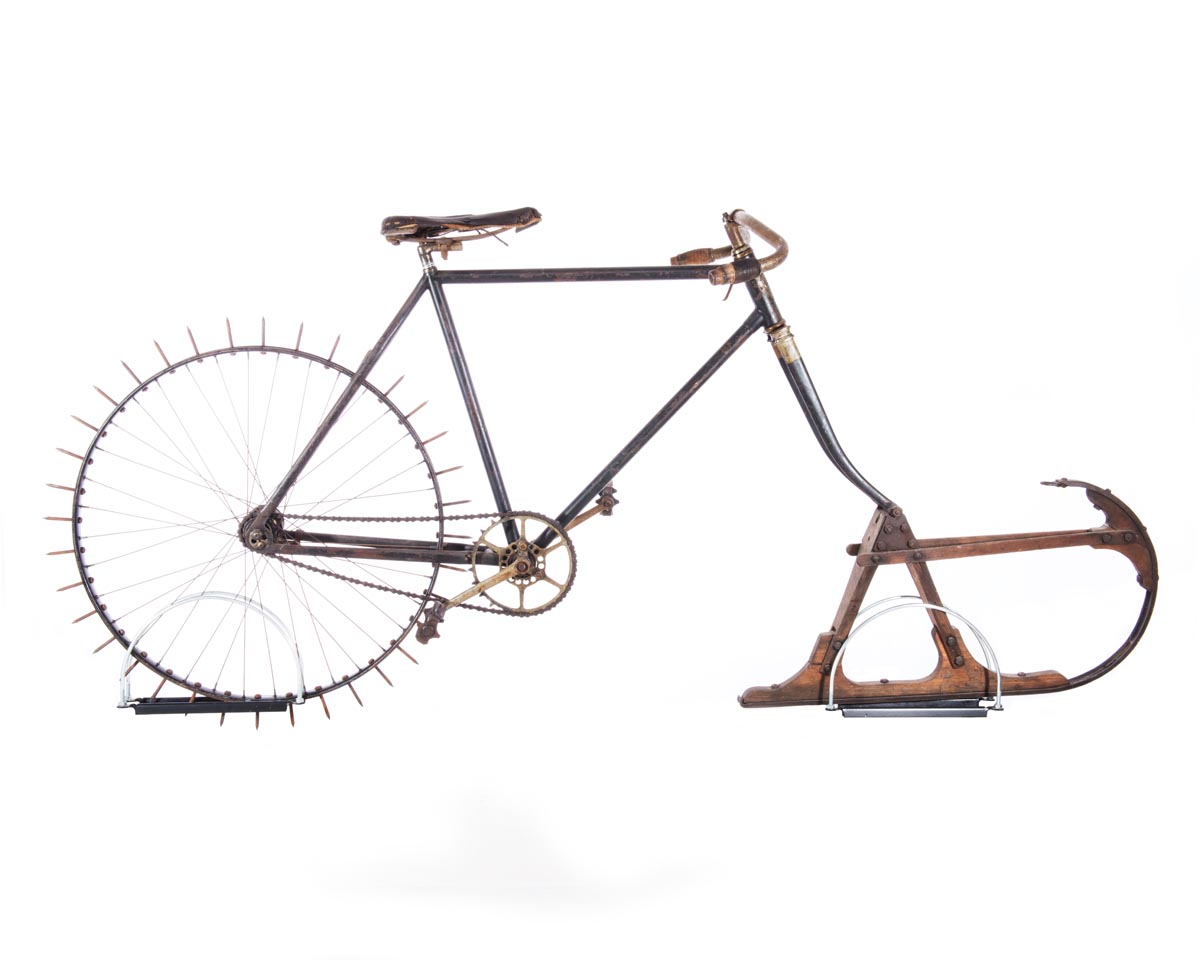
Wolff-American Ice Bicycle, 1901, R. H. Wolff & Co. Ltd. (American, active late 1890s to early 1900s), steel with leather saddle, Bicycle Museum of America, New Bremen, Ohio
Description
Hi, I’m Emily Agricola Holtrop, the museum’s director of learning & interpretation. I will be sharing a description of the Wolff-American Ice Bicycle in Cycle Thru! The Art of the Bike.
The Wolff-American Ice Bicycle is made of steel and features a leather saddle. R.H. Wolff & Company (American, active from the late 1890s to the early 1900s) manufactured it in 1901. It is in the collection of The Bicycle Museum of America in New Bremen, Ohio.
The Wolff-American Ice Bicycle measures 37 by 79 by 22 inches or 93.98 by 200.66 by 55.88 centimeters. This unique bike design pairs a rear wheel, studded with metal spikes, with a curved wooden and metal sled runner where a front wheel is traditionally present. The black steel frame takes the shape of a diamond. It is intersected through its top and bottom points by a straight bar that connects the seat and the pedal mechanism. The side points of the diamond-shaped frame are connection points for the rear wheel and the handlebars. Another bar connects the handlebars to the sled runner. The chain connecting the pedals to the rear wheel is exposed. The handlebars are low, in the style of a modern 10-speed bicycle, so the rider must lean over to grip them.
Label
Hi, I’m Emily Agricola Holtrop, the museum’s director of learning & interpretation. I will be sharing the label for the Wolff-American Ice Bicycle in Cycle Thru! The Art of the Bike.
The Wolff-American Ice Bicycle is made of steel and features a leather saddle. R.H. Wolff & Company (American, active from the late 1890s to the early 1900s) manufactured it in 1901. It is in the collection of The Bicycle Museum of America in New Bremen, Ohio.
In addition to manufacturing "high art cycles," the New York firm of R.H. Wolff & Co. Ltd. also created specialty kits. Endeavoring to make cycling a year-round activity, Wolff designed a kit to convert a bike's front wheel into a sled runner. The drilled rear wheel accommodated large studs that would bite into the ice, providing traction. While the concept of the ice cycle may seem unusual and limited in market appeal, various models have appeared throughout history, including contemporary versions used in the up-and-coming sport of icetrack cycling.
Dursley Pedersen
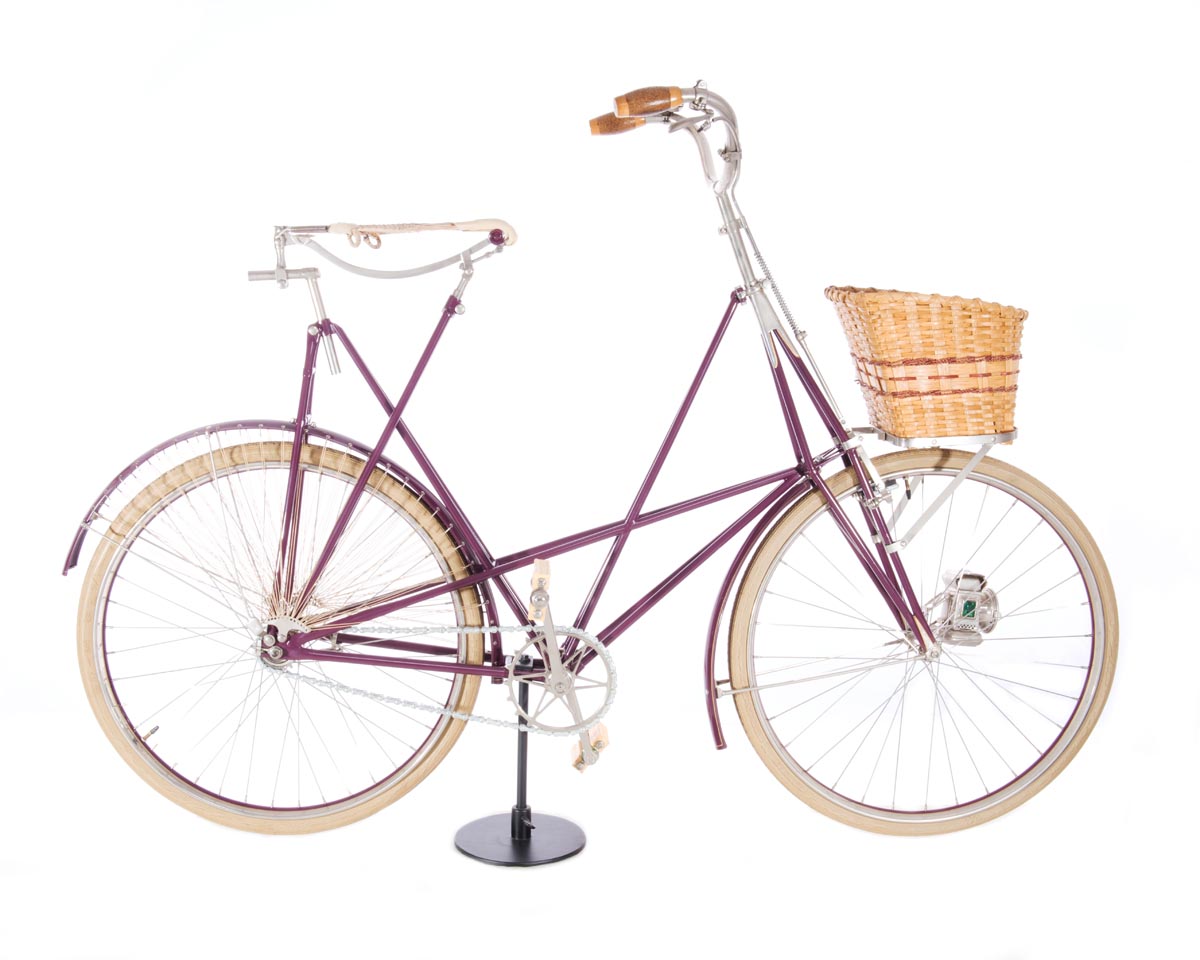
Dursley Pedersen, 1910, Mikael Pedersen (Danish, active in England, 1855–1929) steel frame with cloth saddle and wicker basket, Bicycle Museum of America, New Bremen, Ohio
Description
Hi, I’m Emily Agricola Holtrop, the museum’s director of learning & interpretation. I will be sharing a description of the Dursley Pedersen in Cycle Thru! The Art of the Bike.
Mikael Pedersen (Danish, active in England, 1855–1929) designed the Dursley Pedersen in 1910. It has a steel frame, cloth saddle, and wicker basket. It is in the collection of The Bicycle Museum of America in New Bremen, Ohio.
The Dursley Pederson cycle measures 45 by 62 by 18 inches or 114.3 by 157.48 by 45.72 centimeters. This purple bike’s steel frame is composed of three interconnected triangles. The first triangle, at the front of the bike frame, connects the handlebar stem, front wheel, and pedal mechanism. The second triangle, at the center of the bike frame, connects the front wheel, the pedal mechanism, and the back wheel. The last triangle, at the back of the bike frame, connects the saddle, the rear wheel, and the pedal mechanism. On the front of the bike, just in front of the wide-set handlebars, is a tan wicker basket suspended on metal supports over the front wheel. A lamp is also attached to this wheel, just above the center. The seat resembles a hammock supported by a curved metal frame. Both the front and rear wheels have cream-colored rubber tires and purple fenders. The chain connecting the pedals to the rear wheel is exposed.
Label
Hi, I’m Emily Agricola Holtrop, the museum’s director of learning & interpretation. I will be sharing the label for the Dursley Pedersen in Cycle Thru! The Art of the Bike.
Mikael Pedersen (Danish, active in England, 1855–1929) designed the Dursley Pedersen in 1910. It has a steel frame, cloth saddle, and wicker basket. It is in the collection of The Bicycle Museum of America in New Bremen, Ohio.
Mikael Pedersen was an inventor and avid cyclist. After creating notable agricultural innovations, he shifted his focus to improving the newly popular safety bicycle. Inspired by railroad truss bridges, he based his bicycle frame on the most stable geometric form: the triangle. Utilizing the triangular truss structure, the frame can carry a considerable load while remaining relatively lightweight. Pedersen also invented the hammock-style bicycle seat that riders can adjust using the leather strap at the front to make it tighter or slacker for comfort.
Shifting Gears: Bicycles in the Time of Automobiles (1930s–40s)
Hi, I’m Greg Ervin, the museum's associate director of foundation engagement. I will be sharing the introduction to the “Shifting Gears: Bicycles in the Time of Automobiles (1930s–1940s)” section of the exhibition.
Bicycles paved the way for the automobile. The cycling trade launched the Good Roads Movement, eventually leading to the development of national highway networks. Manufacturers developed techniques to efficiently assemble millions of bikes and later adapted them to automobile production, and the nationwide grid of bike repair shops became some of the first gasoline stations.
To compete with the rise of the automobile, bicycle manufacturers focused on producing bikes for young riders and recasting the tried-and-true bicycle design in the latest artistic styles. Many firms hired car designers who introduced modern styles and features associated with motorized vehicles. Bicycles soon sported integrated headlights and horns, speedometers, glossy paint finishes, pinstriped details, and chrome.
In 1936, Sears charged their lead product designer, John "Jack" Morgan, a former General Motors car designer, to style three new bikes—all with sleek Art Deco details. Of those, the Bluebird and the Skylark are displayed here. Morgan also designed the later Twin Bar.
Elgin Bluebird
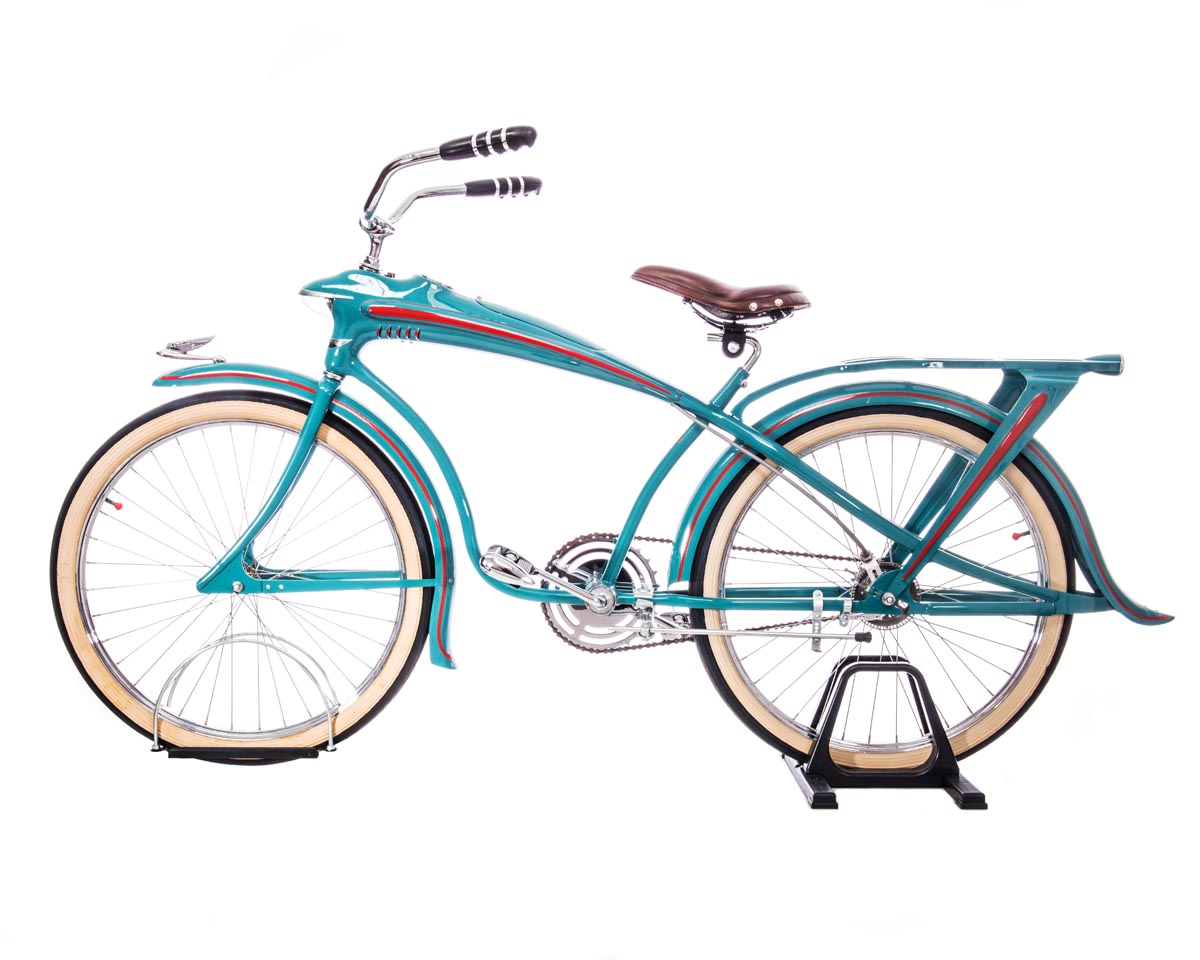
Elgin Bluebird, 1936, John "Jack" Morgan (American, b. Guatemala, 1903–1986), designer, Sears, Roebuck & Co. (American, est. 1893), retailer, Westfield Manufacturing Company (American, est. 1916), manufacturer, steel with leather saddle, Bicycle Museum of America, New Bremen, Ohio
Description
Hi, I’m Greg Ervin, the museum's associate director of foundation engagement. I will be sharing a description of the Elgin Bluebird in Cycle Thru! The Art of the Bike.
The Elgin Bluebird is made of steel and features a leather saddle. John "Jack" Morgan (American, born in Guatemala, 1903–1986) designed the cycle, the Westfield Manufacturing Company (American, established in 1916) manufactured it, and the Sears, Roebuck and Company (American, established in 1893) sold it. It is in the collection of The Bicycle Museum of America in New Bremen, Ohio.
The Elgin Bluebird measures 42 by 80 by 26 inches or 106.68 by 203.2 by 66.04 centimeters. A bright robin’s egg blue with red detailing, this cycle’s 1930s automobile-like curves are its distinctive feature. Starting from the base of the wide-set chrome handlebars, the steel frame narrows from a wide curve to a thinner bar as it stretches to and underneath the saddle stem, continuing on to connect to the fender at the center back of the rear wheel. Another set of bars runs on either side of the rear wheel’s center to the pedal and chain mechanism. A bar runs from under the handlebar frame to the center of the front wheel, slightly curving forward. The tires sport flared-end fenders. The top of the front fender features a decorative ornament, like those displayed on car hoods. A metal rack to carry parcels or passengers is suspended over the back wheel.
Label
Hi, I’m Greg Ervin, the museum's Associate Director of Foundation Engagement. I will be sharing the label for the Elgin Bluebird in Cycle Thru! The Art of the Bike.
The Elgin Bluebird is made of steel and features a leather saddle. John "Jack" Morgan (American, born in Guatemala, 1903–1986) designed the cycle, the Westfield Manufacturing Company (American, established in 1916) manufactured it, and the Sears, Roebuck and Company (American, established in 1893) sold it. It is in the collection of The Bicycle Museum of America in New Bremen, Ohio.
The modern sweeping lines of the Bluebird, sold exclusively by Sears under the "Elgin" brand name, visually suggest flight and speed—two popular infatuations during the 1920s and 1930s. Riffing on automobile design, bicycles like this were painted and pinstriped in bright, eye-catching colors accented with chrome-plated elements and often sported built-in headlights, electric horns, and speedometers.
Rocket
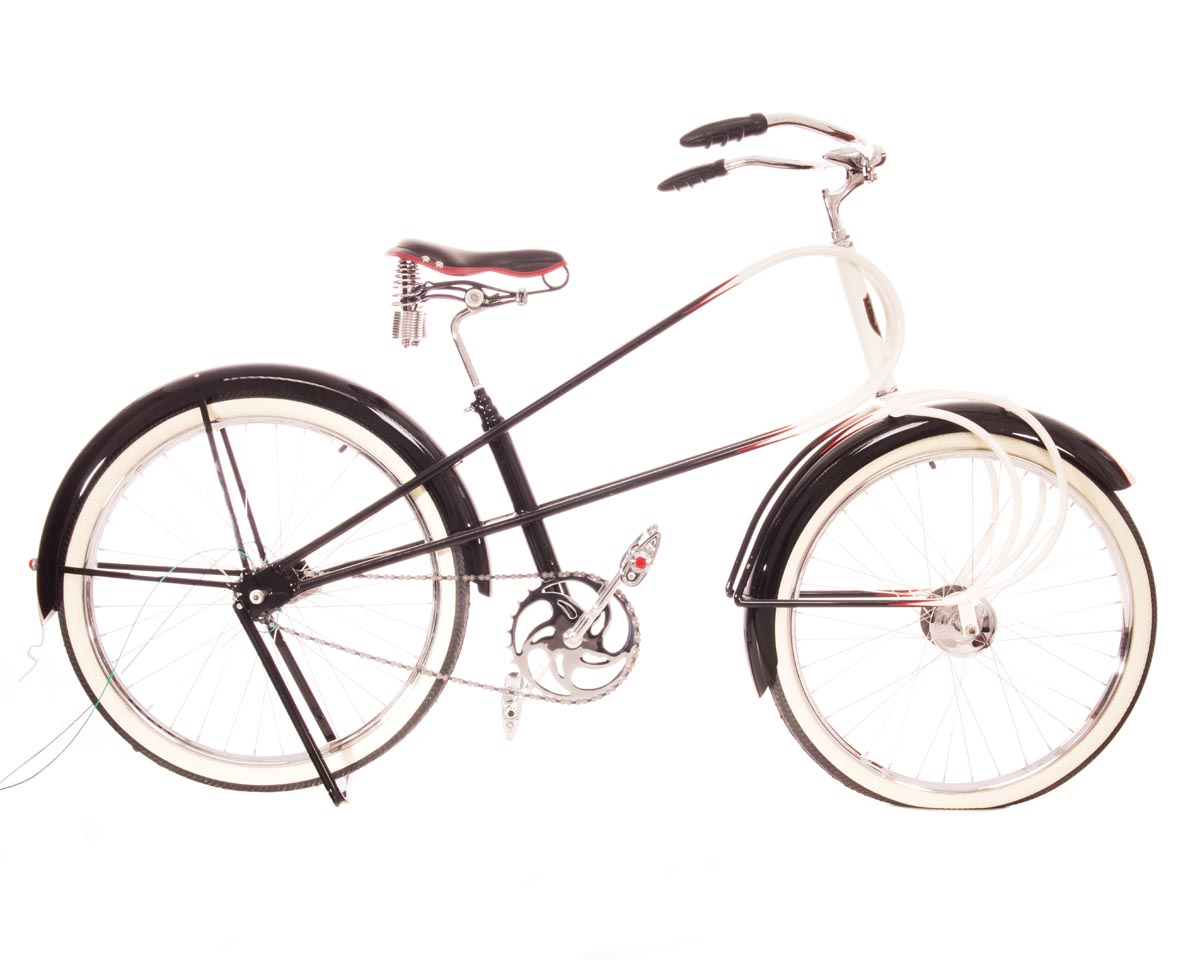
Rocket, 1940, John R. Alexander (American, designer), Alexander Specialty Manufacturing (American), steel with leather saddle, Bicycle Museum of America, New Bremen, Ohio
Description
Hi, I’m Greg Ervin, the museum's associate director of foundation engagement. I will be sharing a description of the Rocket in Cycle Thru! The Art of the Bike.
The Rocket is made of steel and features a leather saddle. John R. Alexander (American) designed the cycle, and the Alexander Specialty Manufacturing Company (American, active 1940s) manufactured it in 1940. It is in the collection of The Bicycle Museum of America in New Bremen, Ohio.
The Rocket cycle measures 44 by 72 by 27 inches or 111.76 by 182.88 by 68.58 centimeters. A teardrop-shaped steel frame is this bike’s most notable feature. Extending from a tapered point at the center of the rear wheel, the tear-shaped frame expands diagonally upwards until it connects to the handlebar stem. At its narrowest, the bar features a glossy black finish, gradually shifting to a deep brown as the shape expands and ends in a glossy white rounded end. A set of teardrop curved bars, also white on the round part and transitioning to black as the form narrows, envelopes the top of each side of the front wheel. Each teardrop shape features red detailing, where the color shifts from white to brown. Both the front and the back wheels have black fenders. A frame component connects the saddle to the chrome pedals and chain mechanism, which is exposed as it connects the pedals to the rear wheel. The saddle, with a spring mechanism underneath that supports its broadest end, is black leather with red trim.
Label
Hi, I’m Greg Ervin, the museum's Associate Director of Foundation Engagement. I will be sharing the label for the Rocket in Cycle Thru! The Art of the Bike.
The Rocket is made of steel and features a leather saddle. John R. Alexander (American) designed the cycle, and the Alexander Specialty Manufacturing Company (American, active 1940s) manufactured it in 1940. It is in the collection of The Bicycle Museum of America in New Bremen, Ohio.
In 1939, John R. Alexander of Paris, Texas, applied to patent the first iteration of the Rocket. He designed its tear-shaped fork, which supports the front wheel, to absorb jolts to the rider and bike frame when navigating rough roads. Later, he repeated the tear shape as an ornamental detail of the Rocket's frame. Engineers and designers involved in early aerodynamic testing in the late 1800s and early 1900s identified the teardrop as one of the most effective shapes for speed. Soon, zeppelins, automobiles, and even bikes exhibited this streamlined shape.
BSA Airborne
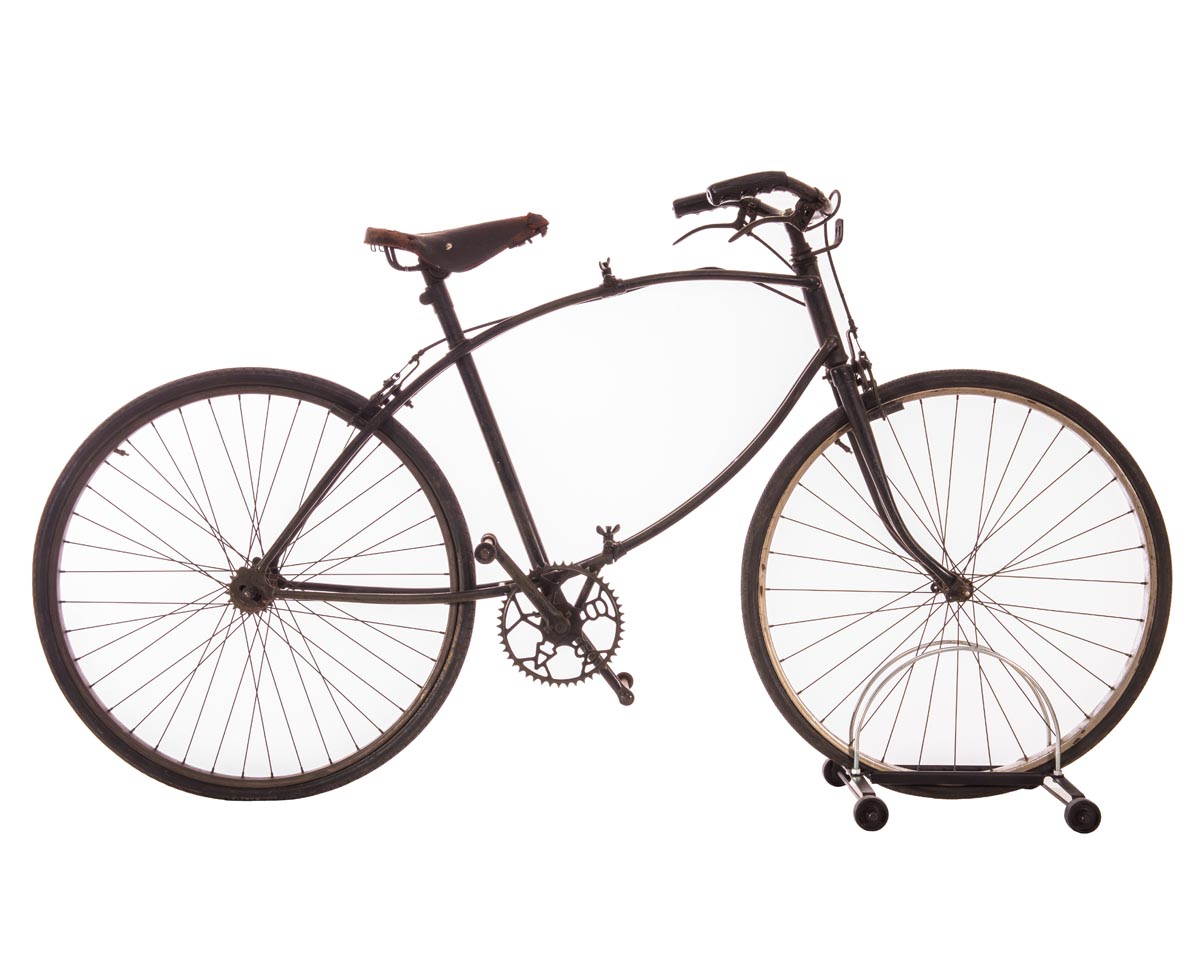
BSA Airborne, 1942–46, Birmingham Small Arms Company (English, 1861–1973), steel with leather saddle Bicycle Museum of America, New Bremen, Ohio
Description
Hi, I’m Amy Burke, the museum's director of visitor experience. I will be sharing a description of the BSA Airborne in Cycle Thru! The Art of the Bike.
The Birmingham Small Arms Company (English, 1861–1973) manufactured the BSA Airborne between 1942 and 1946. It is made of steel and features a leather saddle. It is in the collection of The Bicycle Museum of America in New Bremen, Ohio.
The BSA Airborne measures 39 and three-eighths by 78 and three-quarters by 19 and eleven-sixteenths inches or 100 by 200 by 50 centimeters. This bike has a utilitarian, minimal design. A tubular, double-bar, black steel frame runs slightly diagonally from the handlebar stem to the rear wheel, intersecting the straight vertical stem that connects the seat to the pedals. Terminating at the center of the rear wheel, this frame creates a squished oval shape. At the top center of each bar is a wingnut screw and hinge, which allows the bike to fold in half. The handlebars are upright, and each rubber hand grip has a brake handle. The lefthand brake line extends along the upper bar of the curved frame to a brake at the top of the rear tire; the righthand brake line extends straight down from the handlebars to a brake on the front tire. The dark brown leather saddle is triangular and unpadded. The pedals consist of two pegs, and the chain is missing. Both wheels have thick rubber tires.
Label
Hi, I’m Amy Burke, the museum's director of visitor experience. I will be sharing the label for the BSA Airborne in Cycle Thru! The Art of the Bike.
The Birmingham Small Arms Company (English, 1861–1973) manufactured the BSA Airborne between 1942 and 1946. It is made of steel and features a leather saddle. It is in the collection of The Bicycle Museum of America in New Bremen, Ohio.
Designed for British paratroopers during World War II, this bicycle was lightweight and foldable. Carrying this mode of ground transportation with them as they jumped out of airplanes, soldiers unfolded the bike and tightened the two wing nuts to secure the opened frame once they landed. These specialty cycles enabled paratroopers to cover larger distances on the ground while remaining quiet and, hopefully, undetected. Soldiers used bicycles like this in many historic battles, including D-Day, the 1944 Allied invasion of Normandy, France, which marked the liberation of western Europe, the defeat of Nazi Germany, and the end of World War II.
Be-Spoke Rides: Mid-Century Modifications to the Bike (1950s–60s)
Hi, I’m Carrie Atkins Maras, the museum’s associate director for community engagement. I will be sharing the introduction to the “Be-Spoke Rides: Mid-Century Modifications to the Bike (1950s–1960s)” section of the exhibition.
Technological developments like the transistor radio and the space race inspired new bicycle designs in the 1950s and 1960s. Seeing potential in the post-World War II baby boom, most American manufacturers focused on producing bikes for children and teens. The suburban sprawl that typified the era created longer distances between neighborhoods and streets with lower traffic volume. A cool bicycle was essential for making friends, meeting up, and hanging out.
Huffy Radiobike
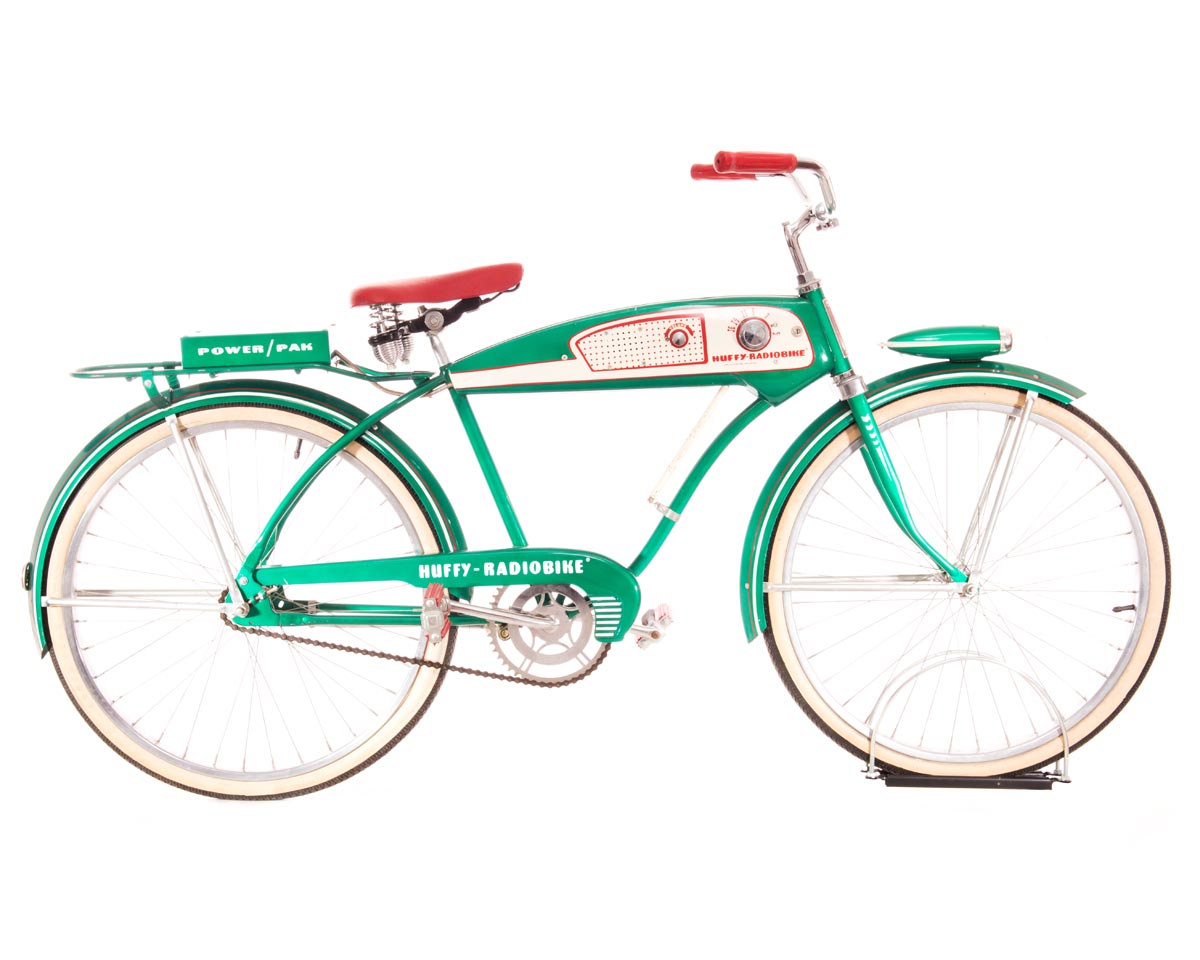
Huffy Radiobike, 1956, Huffman Manufacturing Company (American), steel with leather saddle, Bicycle Museum of America, New Bremen, Ohio
Description
Hi, I’m Carrie Atkins Maras, the museum’s associate director for community engagement. I will be sharing a description of the Huffy Radiobike in Cycle Thru! The Art of the Bike.
The Huffman Manufacturing Company (American, established in 1924) created the Huffy Radiobike in 1956. It is made of steel and features a leather saddle. It is in the collection of The Bicycle Museum of America in New Bremen, Ohio.
The Huffy Radiobike measures 39 by 72 by 25 inches or 99.06 by 182.88 by 63.5 centimeters. Bright Kelly green with red and white accents, the frame of this bike incorporates a radio. The horizontal steel frame bar extending from the handlebar stem to the saddle is wide from top to bottom, with the top of the bar curving slightly downwards towards the rear wheel. This space houses a radio dial and a speaker with volume control. The words “Huffy Radiobike” are outlined in red on a white background below the radio dial. Additional green frame components curve down from under the radio and straight down from the saddle to terminate at the square pedals with red rubber grips. The top of the chain mechanism is protected by a green fender that reads “Huffy Radiobike.” Both wheels, complete with green fenders, are white with black rubber treads. A green oval light with chrome and white accents is perched atop the front fender. The radio’s rectangular “Power Pak” battery and a rack are suspended above the back fender by thin green metal supports. Metal springs support the rear end of the triangular red leather saddle. The upright and wide-set chrome handlebars have red rubber grips.
Label
Hi, I’m Carrie Atkins Maras, the museum’s associate director for community engagement. I will be sharing the label for the Huffy Radiobike in Cycle Thru! The Art of the Bike.
The Huffman Manufacturing Company (American, established in 1924) created the Huffy Radiobike in 1956. It is made of steel and features a leather saddle. It is in the collection of The Bicycle Museum of America in New Bremen, Ohio.
A fast, sharp-looking bike with a radio made you the "most popular kid on the street," according to Huffy's ads for the new Radiobike. The vacuum tube radio, produced by the Yellow Springs Instrument Company of Ohio, was modeled as a faux gas tank and powered by the battery pack on the bike's rear rack. Dayton-based Huffy produced about 8,500 Radiobikes between 1955 and 1956. While the company marketed the radio as waterproof, it halted production after riders reported that exposure to inclement weather caused the radio to spark.
Sears Spaceliner
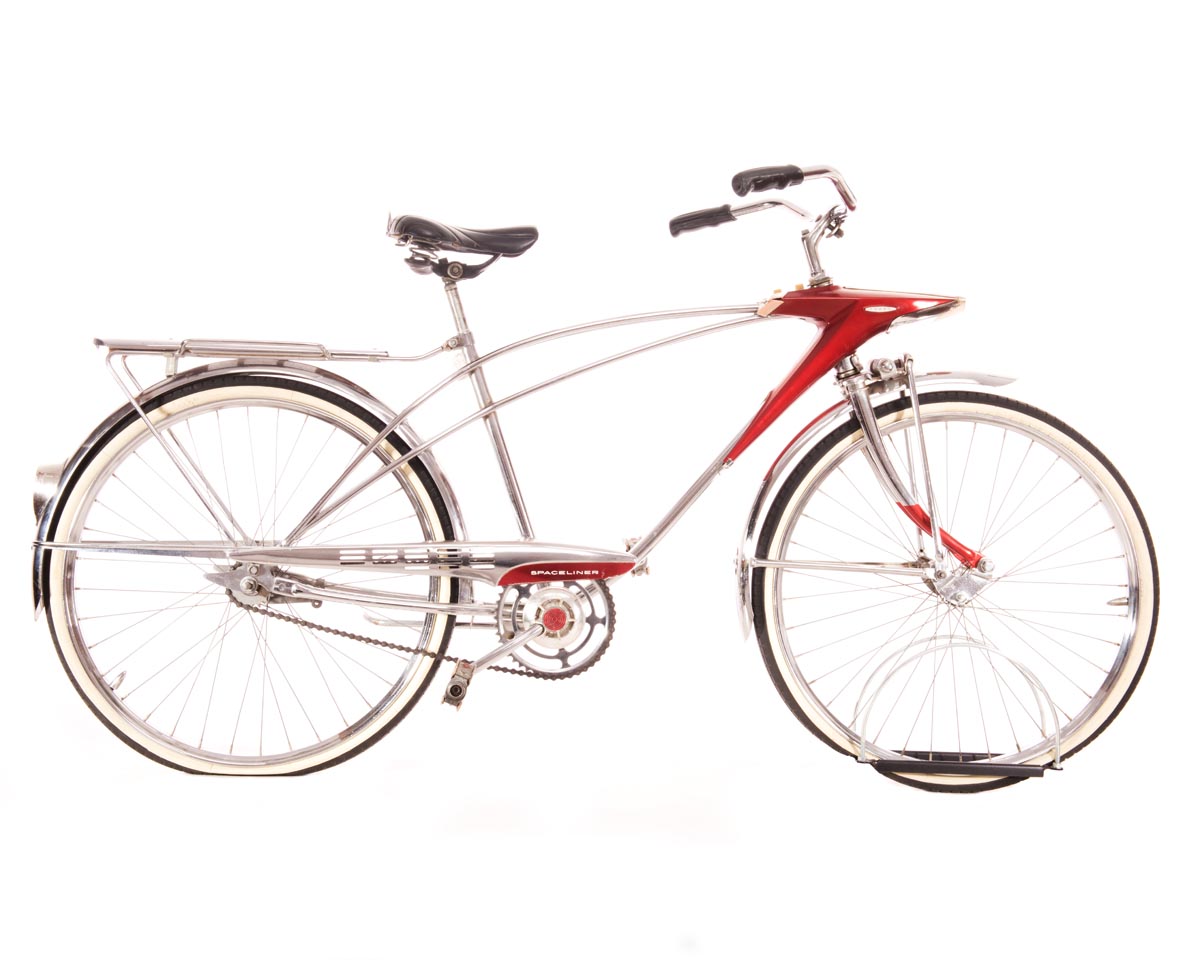
Sears Spaceliner, 1965, Viktor Schreckengost (American, 1906–2008), designer, Murray Ohio Manufacturing Company (American, 1919–1988), manufacturer, Sears, Roebuck & Co. (American, est. 1893), retailer, steel and plastic frame with leather saddle, Bicycle Museum of America, New Bremen, Ohio
Description
Hi, I’m Carrie Atkins Maras, the museum’s associate director for community engagement. I will be sharing a description of the Sears Spaceliner in Cycle Thru! The Art of the Bike.
The Sears Spaceliner has a steel and plastic frame and a leather saddle. Viktor Schreckengost (American, 1906-2008) designed the cycle, the Murray Ohio Manufacturing Company (American, operating between 1919 and 1988) manufactured it, and the Sears, Roebuck, and Company (American, established in 1893) sold it. It is in the collection of The Bicycle Museum of America in New Bremen, Ohio.
The Sears Spaceliner measures 38 by 69 by 26 inches or 96.52 by 175.26 by 66.04 centimeters. Aptly named, this bike has a 1960s-era streamlined space-age design. Starting at the front of the bike, just under the upright chrome handlebars with black hand grips, the glossy red frame juts out to a point before widening into a triangular shape and then breaking into three frame components. A bar running diagonally underneath the handlebars extends the red form, retaining the vivid color at its wider top before shifting to a narrower chrome bar as it continues down to the pedal mechanism. Just behind the handlebar stem, the red design element narrows and divides into two narrow chrome bars that curve down to the rear wheel, creating a narrow eyebrow shape. These bars intersect a straight vertical chrome bar that joins the padded black leather saddle to the pedals. The front and rear rubber tires and the pedal mechanism all have chrome fenders with red detailing. The bike's name, “Spaceliner,” is written in white on a red background on the pedal fender. This fender continues the space-age design of the rest of the bike: it is narrow at the front of the chain wheel, then widens slightly over the top of the pedals before narrowing dramatically to a point and connecting to the fender at the center back of the rear wheel. Just above this point, a reflector is built into the metal fender. A rack is attached to the rear wheel’s center and is suspended above the back fender.
Label
Hi, I’m Carrie Atkins Maras, the museum’s associate director for community engagement. I will be sharing the label for the Sears Spaceliner in Cycle Thru! The Art of the Bike.
The Sears Spaceliner has a steel and plastic frame and a leather saddle. Viktor Schreckengost (American, 1906-2008) designed the cycle, the Murray Ohio Manufacturing Company (American, operating between 1919 and 1988) manufactured it, and the Sears, Roebuck, and Company (American, established in 1893) sold it. It is in the collection of The Bicycle Museum of America in New Bremen, Ohio.
With lines that could cut through the Milky Way, the Spaceliner was one of more than 100 bicycles styled by the great American designer Viktor Schreckengost for Sears. Its forward lilting frame virtually propelled it off the catalog page and onto the wish list of American youths who dreamt of exploring space themselves one day. Ohio-born Schreckengost founded the first industrial design program in the nation at the Cleveland Institute of Art. Throughout his 70-year career, he designed everything from kitchen appliances to pedal cars.
The Cycle Continues: The Bicycle Today (2010s–2020s)
Hi, I’m Erin Carmichael-Morgan, the museum's coordinator for the Rosenthal Education Center. I will be sharing the introduction to the “The Cycle Continues: The Bicycle Today (2010s–2020s)” section of the exhibition.
The bicycle is here to stay and continues to evolve. Notice the variety of bicycle styles and representations in this gallery and consider how the more recent designs reflect our changing realities, needs, and desires. We still pursue speed and comfort but also environmental sustainability and joyful social interaction. What will be the next phase of this "cycle"?
Bike from the Cicloviaérea series
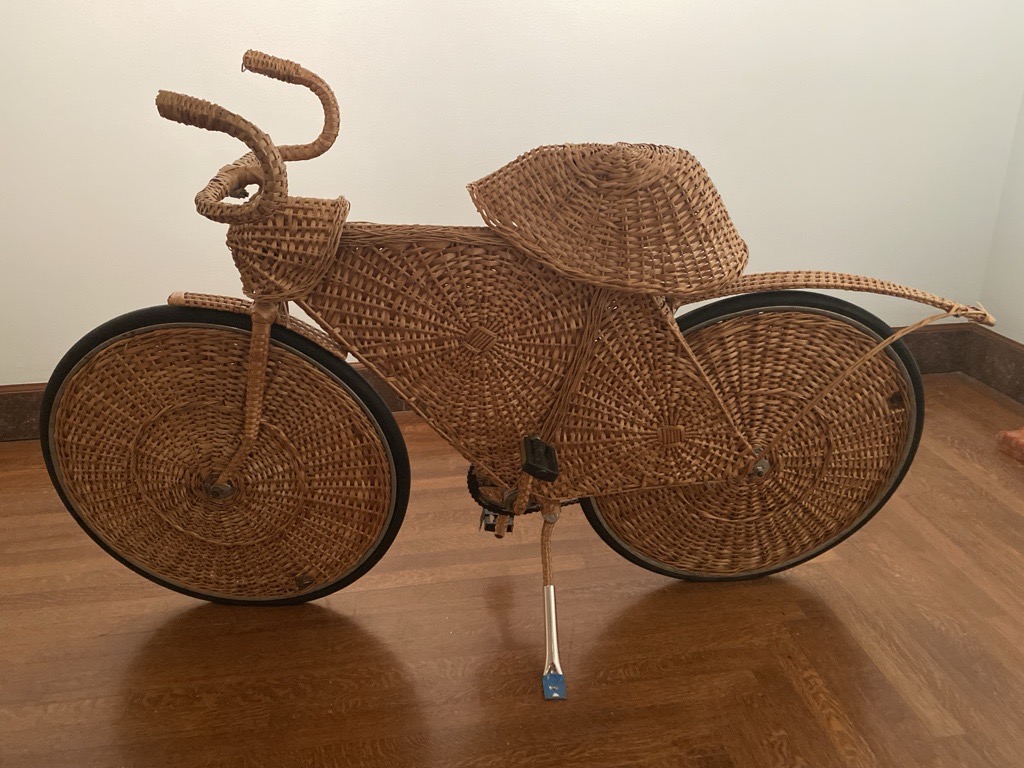
Bike from the Cicloviaérea series, 2001–20, Jarbas Lopes (Brazilian, b. 1964), wicker-wrapped bicycle, Collection of Steve Miller
Description
Hi, I’m Erin Carmichael-Morgan, the museum's coordinator for the Rosenthal Education Center. I will be sharing a description of the Bike from the Cicloviaérea series in Cycle Thru! The Art of the Bike.
Bike from the Cicloviaérea series is a wicker-wrapped cycle dating from 2001 to 2020. Jarbas Lopes (Brazilian, b. 1964) created it, and it is in the private collection of Steve Miller.
The Bike from the Cicloviaérea series measures 36 by 50 by 24 inches or 91.44 by 127 by 60.96 centimeters. Jarbas Lopes, the artist who created this cycle, likely started with the frame of a 10-speed bike. The bars that connect the handlebars, saddle, and pedals form a large triangle. Both the front and back wheels have rubber tires and fenders. The square black pedals are made from plastic and feature orange reflectors. The bike’s handlebars are those of a 10-speed, but instead of being in the traditional lower position so that the rider would need to bend over to grip them, they are elevated and face away from the cyclist to allow for easier riding.
The most distinctive aspect of this bike is the woven wicker decoration that covers every frame element except the tires, pedals, and chain. Lopes repeated a circular, basket-like pattern in the woven cane to decorate each of the wheels, the central frame of the bike, the chain wheel, the intersection of the handlebar stem and the top bar of the bike’s frame, and what appears to be a dress guard extending over the rear wheel are also covered in wicker woven in circular patterns. A squished circular basket form drapes over the seat. Wicker caning wraps the handlebars, fenders, support bars on either side of each wheel, and the pedal rod.
Label
Hi, I’m Erin Carmichael-Morgan, the museum's coordinator for the Rosenthal Education Center. I will be sharing the label for the Bike from the Cicloviaérea series in Cycle Thru! The Art of the Bike.
Bike from the Cicloviaérea series is a wicker-wrapped cycle dating from 2001 to 2020. Jarbas Lopes (Brazilian, b. 1964) created it, and it is in Steve Miller's collection.
Jarbas Lopes sees art as a means for people to shape and interact in society. He often reworks everyday objects as part of his practice. This bicycle, covered in wicker, is still functional. It is part of Lopes's Cicloviaérea, or Aerial Bikeway, project that proposes the bike as a primary source of transportation in urban Brazil and advocates for the construction of raised bike paths to decrease congestion and pollution. Lopes's beautiful wicker patterns visually shake up our notion of how a bicycle should look, suggesting the joy and positivity that could come from implementing Cicloviaérea.






